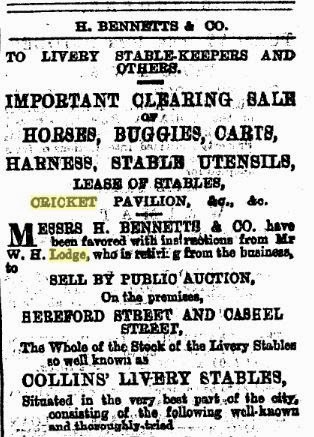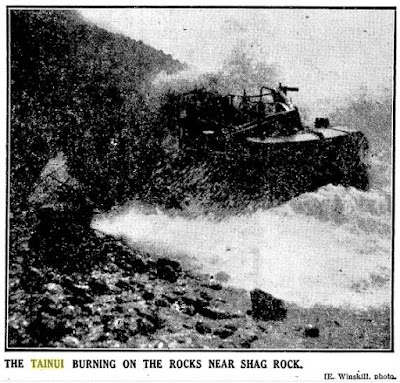Early Canterbury Indoor cricket pavilion
Trawling through Paperspast on the NZ National Library website, I discovered that my GGG Uncle William LODGE [1850-1913, son of Rosannah LODGE and stepson of Thomas Seth LODGE] had an indoor cricket pavilion built in Christchurch. This was beside the then Collin's Hotel [later to become The Occidental Hotel].
As far as I'm aware this would have been Christchurch's first indoor cricket facility as the pavilion at Lancaster Park was in the planning stages when this one was commenced in 1882.
The photo below is c1889 - Cricket pavillion under arrow

The Star, 21 March 1882 reports :
"Cricket will soon become as common a pastime in winter as in summer. In addition to the proposed pavilion for winter practice at Lancaster Park, Mr Lodge has commenced the erection of a similar building in Hereford street, next to Collins Hotel. The structure is to be wide enough to allow of two wickets being pitched, and owing to its proximity to the centre of the town, Mr Lodge should have plenty of patronage. A suggestion has been made to import a professional, who should divide his time between the Clubs playing on turf in the Summer, and the frequenters of these pavilions in the winter. It certainly is worth while considering whether some arrangement cannot be arrived at by which the services of a professional could thus be secured." [1]
In April 1882 it was reported in The Press:
Winter Cricket. —A pavilion, 100 ft by 33ft, for cricketing during wet or cold weather, is being erected in Hereford street, adjoining Collins Hotel; by Mr W. H. Lodge. The roof is of corrugated iron, with canvas ceiling, and the walls are of netting, manufactured by Mr Hale. There are four "pitches" made of concrete foundations to be covered with cocoanut [sic] matting.[3]
The Star, 1 June 1882 reports on a large fire but that:
"The Cricket pavilion [sic] in front also escaped serious injury owing chiefly to its iron roof and brickwork corners."
Full article:
Hereford Street.
... the bell at the Lichfield street station rang, out an alarm, and was followed in a few minutes by the Chester street bell. The scene of the fire was an eight-stalled stable, with living-rooms attached, and hay loft above, situated in a lane running between Cashel and Hereford streets, and close to Collins Hotel. The building belonged to Mr H Cooper, landlord of the hotel, and was leased to Mr W. H. Lodge, who occupied the dwelling-house with his family, and used the stable for the purposes of a livery stable. The fire, when discovered, was bursting through the upper portion of the east end of the building, having evidently begun in the hay loft near the chimney. The Fire Brigade and regular and Fire Police were quickly on the spot, and willing hands were found in plenty to rescue the horses and furniture. Mrs Lodge, with four children, was in the building at the time, but got out without difficulty. Mr Lodge being in the lower part of the house was unaware that anything was wrong till alarmed by some person knocking at the door. The steamer Deluge was placed in position at the tank opposite the White Hart Hotel, and the hose was brought up Cashel street. Owing to the distance, some 260 yards, the water did not reach the fire till about fifteen minutes after the alarm had been given. An attempt was also made to obtain water from the Madras street sewer, but without success, as the trap of the sewer could not be opened. The flames had by this time obtained a fast hold, being fed by the hay, straw and other dry materials stored in the stable loft. A good deal of the furniture and harness had been got out, but it was evident that there was no hope of saving the building, which was burning like a match box. Fortunately, there was scarcely any wind, and the brigade were able to confine the flames to the structure where they broke out. The brigade worked with the utmost zeal and coolness, and their well-directed efforts, in spite of the comparatively small supply of water, soon rendered the surrounding buildings perfectly secure. All the engines were out, but were not brought into play owing to the insufficient water supply. By half-past eight all danger was over, but the engine continued playing on the embers until nine o'clock. The loose box and coach-house at the back, which were connected with the structure destroyed, were only scorched. The cricket pavilion in front also escaped serious injury, owing chiefly to its iron roof and brickwork corners. During the progress of the fire some excitement prevailed among the spectators, on account of an unfounded rumour that one of the children had been left in the house. One of the upstairs rooms was occupied by two cabmen, named Scott and Walsh, who are heavy losers. It is believed that some harness belonging to one of them was saved, but Mr Scott lost a cavalry saddle and bridle, and both had all their clothes and some other property consumed. All Mr Lodge's furniture that was in the ground floor rooms was rescued, together with some from the upper storey. Mr Lodge, who is uninsured, has probably suffered loss to the amount of £100. The building was insured in the Northern office for £500. The fire brigade are entitled to great praise for the smartness they showed in discharging their duty, and the regular and fire police deserve credit for the promptitude with which they were on the ground. Fortunately, the services of thesee latter were not required to any great extent. [2]
On 15 September 1882 an advert appeared in The Press advising of the upcoming auction of William LODGE's property and the lease of the pavilion as he was retiring from the business.
On 30 March 1883 a new owner was reported in The Press:
Sources:
[1]
http://tinyurl.com/building-commenced
[about 2/3rd's way down column]
[2]






Comments
Post a Comment